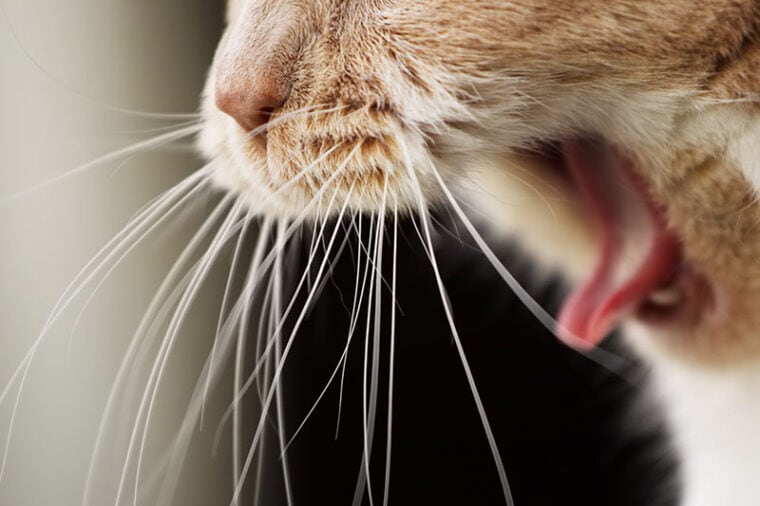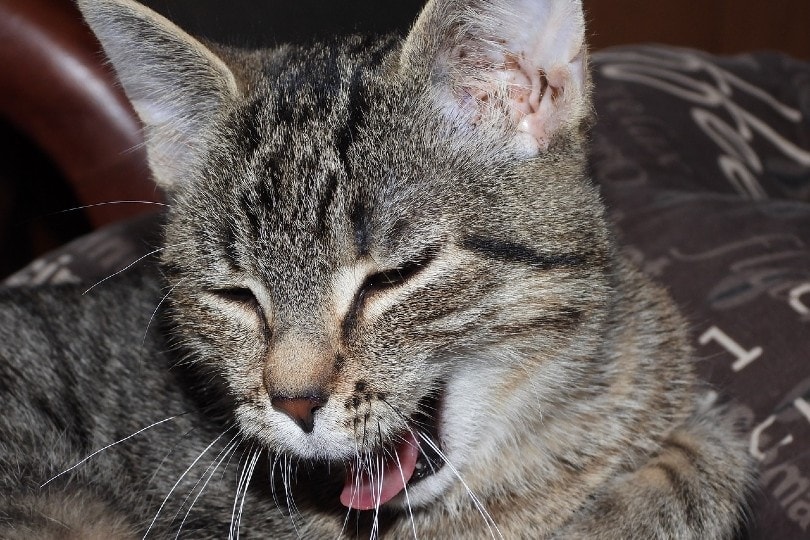
Choking occurs when a cat’s upper airway gets fully or partially blocked, preventing the cat from breathing effectively. Even though choking isn’t all that common in cats, some cats (especially kittens) may be tempted to eat or swallow small toys, string, tinsel, hair ties, shards of bone, and other small objects, putting them at risk of choking.
Choking is an emergency situation and requires fast, appropriate action. As such, it’s best to be prepared and know what to do before the situation arises.
What Are the Symptoms of Choking?
The sudden onset of forceful coughing, gagging, pawing at the mouth, an extended neck, and difficulty breathing in a usually healthy cat suggests that it is choking. If the cat’s airway is fully obstructed, its gums and tongue will become bluish or gray and the cat will lose consciousness within a few minutes.

What to Do if Your Cat Is Choking and Is Still Conscious
A choking cat is anxious and will usually panic. Panicked cats are extremely difficult to restrain, and a struggle may cause the obstruction to lodge even deeper in the throat. Do not attempt to forcibly restrain your cat or open its mouth. Although your natural reaction may be to stick your fingers into your cat’s mouth in an attempt to retrieve obstruction, it’s best not to! You are likely to get bitten and, worse, you may cause the foreign body to work its way deeper down the throat.
The best thing to do is to rush your cat to your closest veterinary hospital. Be sure to call ahead to inform the hospital staff that you are on your way.
What to Do if Your Cat is Unconscious
If your cat has lost consciousness from a lack of oxygen, you’ll need to remove the foreign body as quickly as possible in order to reestablish the airway.
You can do this by gently opening your cat’s jaws, pulling the tongue forward, and sweeping the mouth to the base of the tongue with your index finger. Take care not to push the object further down the cat’s throat with your finger. You may need to use a pair of tweezers to remove the object.
If you find a string in your cat’s mouth, do not attempt to pull it out. The string may be stuck within the cat’s intestines or wrapped around the base of the tongue, and pulling it could cause serious harm. Instead, leave the string as is and take your cat to a veterinarian right away.
If you’re unable to find the object, or if you’re able to see the object but it’s too deep to retrieve, you’ll need to perform the Heimlich maneuver.
Take care when performing the Heimlich maneuver as applying excessive force can cause serious injuries, such as broken ribs and damaged organs. Your cat should be examined by a veterinarian as soon as possible once the object has dislodged.
How to Prevent Your Cat From Choking
Fortunately, choking is largely preventable. Be aware of potential choking hazards in your cat’s environment, and ensure that any item that poses a risk is safely locked away in a pet-proof cupboard or container.
Some of the most common choking hazards include the following:
Are There Any Conditions That Can Be Confused With Choking?
Coughing and retching are often mistaken for choking. Hairballs, feline asthma, and gastrointestinal issues are all common causes of coughing and retching. A cat will usually be able to expel a hairball within a couple of retches. If the symptoms of coughing and retching persist, your cat should be examined by a veterinarian as soon as possible.

Conclusion
Although uncommon in cats, choking is an emergency situation and requires fast, appropriate action—so it’s best to be prepared and know what to do before the situation even arises. The best way to prevent choking is to familiarize yourself with common choking hazards, and to keep your cat’s environment free of these items.
By practicing these precautions, and informing yourself of the best course(s) of action to take, you can ensure your cat is kept safe and happy!
See Also:
- My Cat Ate String, What Should I Do? Vet-Reviewed Facts & Tips
- Brachycephalic Airway Syndrome in Cats: Care &Treatment Guide (Vet Answer)
Featured Image Credit: Suzanne Tucker, Shutterstock








